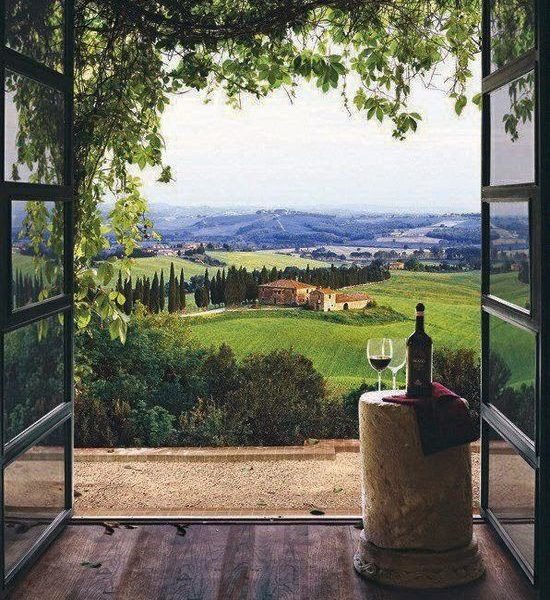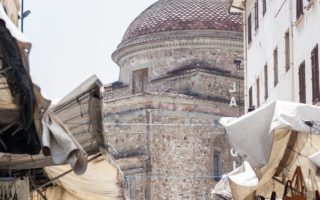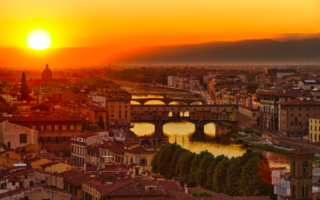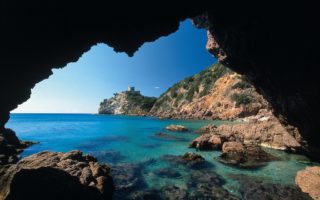Travel, Wine, And Food On A Budget In Tuscany
Italy’s precious jewel, the luscious region of Tuscany, encompasses Florence, the culturally rich city that sparked the Renaissance, and endless stretches of green, amber, and gold countryside. Akin to Florence, which holds some of the world’s finest art museums and architectural phenomena, each Tuscan town is overflowing with riveting legends, ancient history, ornate architecture, authentic cuisine, and delicious wines.
Because of its association with luxury resorts and extravagant wine tastings, Tuscany is not thought of as an ideal destination for budget conscious travelers. However, it is completely possible to plan a trip to Tuscany and not overspend. Using the tips below, travelers who are watching their money can still drink in all of the sights and wine that Tuscany has to offer, without accumulating any over expenditures or regrets.
Because of its association with luxury resorts and extravagant wine tastings, Tuscany is not thought of as an ideal destination for budget conscious travelers. However, it is completely possible to plan a trip to Tuscany and not overspend. Using the tips below, travelers who are watching their money can still drink in all of the sights and wine that Tuscany has to offer, without accumulating any over expenditures or regrets.
How to Move Around
Staying outside the major destinations, like Florence, and visiting them during the day is one great way to save money. Tuscany is easy to get around, either by car or by trains and buses. Renting a car does not have to be expensive, especially if you book in advance. Read more tips about renting a car, driving in Italy, and Italy’s three best road trips here.
If not by car, the best way to get around Tuscany is by train. Trains between cities and towns are frequent. For the cheapest tickets, book on Trenitalia or Italo, at least one month in advance. Check to see if you are eligible for discounts; in Italy many children, families, students, “young travelers,” anyone under the age of twenty-five and sometimes even thirty, and “seniors citizens,” people over the age of sixty, receive discounts on train tickets. These discounts are often applicable when paying for entrance fees to museums, galleries, and historical sites as well, so do not forget to ask.
Within cities and towns, either explore by foot or use buses to get around. Tickets, which can be bought at any local ‘tabaccheria,’ or tobacco shop, are required on buses. Single tickets within a city or town usually cost €1.50 each. Bus trips between towns usually cost a little more.
Where to Stay
Whether renting a car or using public transportation, avoid staying in the more popular tourist destinations, like Florence and San Gimignano, because they are more expensive. Hostels and apartments in the countryside and towns less frequented by tourists are cheaper than any type of hotel. Search Airbnb for shared or private apartments.
The cheapest option for younger travelers are hostels. In the small, enchanting village of ‘Tavarnelle Val di Pesa,’ which is less than an hour by bus from Florence, ‘Ostello di Chianti’ is one fantastic countryside hostel for young travelers on a budget. Shared double, four, or six person rooms with a shared bathroom range from €16 to €25 per person per night.
Although more expensive than hostels or renting an apartment, staying on an ‘agritourismo,’ a farm stay, can be a cheaper way to explore Tuscany. Every agritourismo is a working farm, offering guests wine and food tastings, as well as tours of vineyards, orchards, and farming processes. Some even give guests the chance to work on the farm, offering tasks such as picking olives or bottling wine. Three idyllic ‘agritourismi,’ near the popular San Gimignano, are Agritourismo Cesani, Fattoria Voltrona, and Fattoria di Pancole. With breakfast included, prices range from €60 to €200 per night for single or double rooms or two to four person private apartments on the farm. For couples, families, or groups, farm stays become quite affordable.
Where to Go
Tuscany is literally bursting with beauty, as well as chances to explore, enjoy, and adventure. Whether you have booked an apartment in Prato or Pistoia, two lovely towns just northwest of Florence, or are staying on a farm near San Gimignano, which is more southwest, traveling through Tuscany is a dream. Choose where you would like to visit according to your interests and by taking into account which places are easier to reach by train or by car.
From Prato or any of the bigger towns, like Sienna, Lucca, and Pisa, it is much easier get to Florence by train. However, if you are staying in the countryside or prefer to go by car, it is possible to drive to Florence. Make sure to park outside the city center, because parking becomes increasingly more expensive the closer you get to the center.
Walk to Florence’s center, which is marked by the spectacular domed, Gothic masterpiece, ‘Il Duomo.’ The construction of this staggeringly immense church with a perfectly spherical, red-tinted dome top started in 1296. If you do not have any extra money to spend, simply admire the awe-inspiring structure. If you have €15 more in your budget, buy the combination ticket, which grants you access to the church, dome, baptistery, crypt, museum, and the fourteenth century ‘campanile,’ or bell tower. Walk up the more than four hundred steps to the top of Giotto’s Bell Tower and breathe in the beauty of ‘Firenze.’
 |
| Spectacular Panorama Of The Top Of Giotto’s Bell Tower |
Visit Florence’s second most beautiful church, “Basilica di Santa Croce” and people watch in the piazza outside of the church’s intoxicating white face and walls with intricate, hand painted frescos. Another cost free attraction in Florence, includes exploring the famed bridge, ‘Ponte Vecchio,’ which dates back to as early as 996 and is jauntily lined with shops that now sell jewelry. Walk over the bridge to cross into the ‘Oltarno,’ or the other side of the Arno River, to witness the artisans and craftsman of Florence. Look around at the fresh produce, handmade goods, and authentic leather items at Florence’s many outdoor and indoor markets. Read this guide to Florence’s markets to choose which one of the diverse markets to visit.
The larger of the Tuscan towns that are worth visiting are Lucca, Siena, and Pisa. Do not plan on spending a whole day Pisa. Although the town is extremely touristy, the ‘Torre Pendente di Pisa’ or Leaning Tower of Pisa is a must-see. Plus, it is free! Lucca is an ideal town for a day filled with eating, window shopping, and for a ‘passeggiata’ or leisurely stroll. Visitors can meander along the luxuriously wide walls, which were built during the Renaissance and surround the town center. Another good destination is Siena, which is a pristine medieval town with a fine artistic reputation. The famous ‘Palio di Siena,’ a horse race, is held twice a year in the town’s shell-shaped square, ‘Piazza del Campo.’ Choose which of these larger towns you would like to see and then plan your route to include any nearby smaller ones.
 |
| Race Horse In Piazza del Campo |
When driving or taking the train through Tuscany, small, seemingly untouched towns will suddenly pop up in the highest spaces among the green fields and hills. Famous for its range of towers and tasty pastas, meats, and wine, San Gimignano has been deemed one of the best of these hilltop towns to visit. Because of this, staying there is pricey; however, it is absolutely worth a visit. Wander the sweet streets which wind elegantly among fiercely tall towers of ranging heights. Climb higher in the town and look down at the methodically planted vineyards and serene olive trees that grow naturally in the surrounding, sloping countryside.
Another equally lovely and historically fascinating hilltop town is Volterra, which has been inhabited since the end of the eight century BC. The town has preserved its Etruscan ruins, thick medieval walls, and ancient Roman amphitheater. There are many traditional ‘trattorie,’ well-priced Italian restaurants, which are perfect for a hearty, authentic lunch and some local wine. Other tiny Tuscan towns to consider visiting include Montepulciano, Monteriggioni, Montalcino, Pitigliano, Poppi, and Pienza.
What and Where to Eat and Drink
If breakfast is not provided, you have not stocked up with supplies yet, or you happen to set off early one day, do not worry. The Italian breakfast is one of the cheapest and most delicious delicacies. The typical breakfast of a ‘cappuccino,’ or espresso and steamed milk and a ‘cornetto,’ an Italian pastry filled with either honey, jam, cream, or chocolate, is never more than €3. It is always cheaper if you eat it the Italian way; by standing at the bar. Find out more about coffee etiquette in Italy and the best coffee in Florence here.
Opt for eating lunch out, if your budget only allows for one meal out, and then buy ingredients at the supermarket to cook your other meals. Restaurant lunches are usually cheaper than dinners. Also, restaurants, serve ample portions, because lunch is typically the biggest meal of the day for Italians.
An inexpensive dinner is the Italian ‘aperitivo,’ which is like happy hour and usually lasts from around 7pm to 10pm. For €10, you receive a drink of your choice and food. Sometimes, the food is just snacks which are brought to the table, but more often it is a fresh buffet of pastas, meats, salads, vegetables, and bread. The best part is that you can continue filling up your plate until you burst or the food runs out. Read more about the where to get the best aperitvo in Florence.
 |
| Panino al lampredotto |
Tuscany’s street food, found in cafes, at markets, and on street corners, is incredibly affordable and appetizing. The region is known for the tasty, salted breads, ‘focaccia’ and ‘schiacciata,’ which can be eaten as a snack or as a ‘panino,’ or sandwich. ‘Panini’ that are filled with fresh Tuscan meats, like ‘prosciutto’ or ‘salami’ and cheeses, like ‘pecorino,’ a hard goat cheese or ‘mozzarella,’ a soft cheese made from cow or buffalo milk, and other toppings, like ‘pomodori secchi’ or sun dried tomatoes cost between €3 and €5 each. Florence is famous for ‘lampredotto’ sandwiches, which are filled with cow stomach that has been simmered with onion and spices. Another favorite to serve between slices of Tuscan bread is ‘porchetta,’ which is wild pig that has been seasoned and roasted for hours over a wood burning fire.
As for eating in the countryside, the agritourismi are delightful places to dine. Almost all of these farms, have restaurants where meals are served with food from and wine made on the land. The food is fresh, filling, and cheaper than restaurants in town. If you are exploring the town of Pistoia, which is about halfway between Florence and Lucca, have Sunday lunch or dinner after 8pm on Wednesdays to Sundays at the family run agritourismo, Il Podere Santa Rita. The mother, daughter, and son serve dreamy Tuscan dishes, like ‘pici’ a type of hand-rolled pasta with ‘pecorino’ cheese, sausage, and cabbage, ‘pasta fritta Toscana,’ or fried bread, which is often served with ‘prosciutto crudo,’ cured ham, and the typical Tuscan dessert, ‘cantuccini e vin santo,’ which is a glass of sweet wine served with almond biscuits for dunking. Look out for signs for agritourismi on highways as you travel through Tuscany.
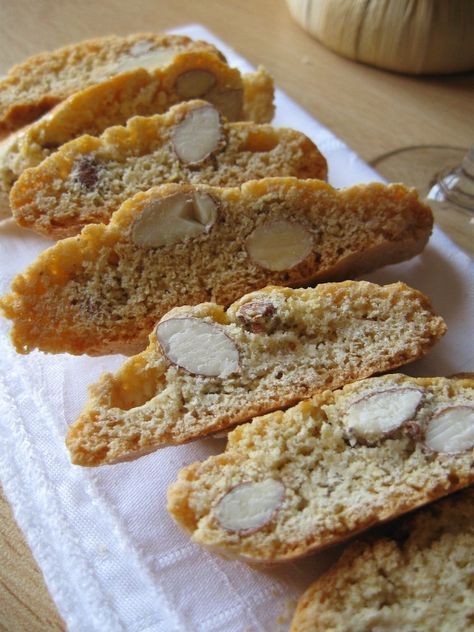 |
| Cantuccini E Vin Santo |
If you are staying at or visit an agritourismo that makes wine, then ask if you can have a tour of the vineyards or taste some wine. Who knows, if you express interest and buy a glass of wine in the evening, maybe the family of farmers will be happy to show you around or if you are a guest, maybe they will let you sample some of their wine. For more about where in Tuscany to wine taste and take organized wine tours, read our ultimate guide to food and wine tasting in Tuscany. Since wine tours are often pricey, instead of booking a tour, soak up the beautiful countryside, especially the vineyard rich area around Chianti, which shares its name with its robust red wine, and instead taste some local wines at any ‘enoteca,’ which are wine shops that sell wine from that region. In an enoteca, you will be able to find excellent wines for less than €5 per glass.
Enjoy Tuscany and let us at Roman Candle Tours know if you discover any other good ways to stay on budget while you travel through ‘bella Toscana.’
